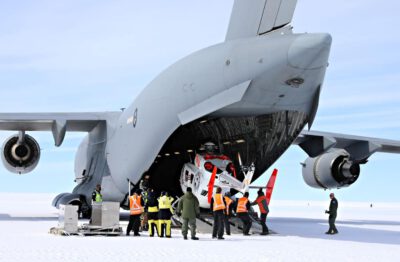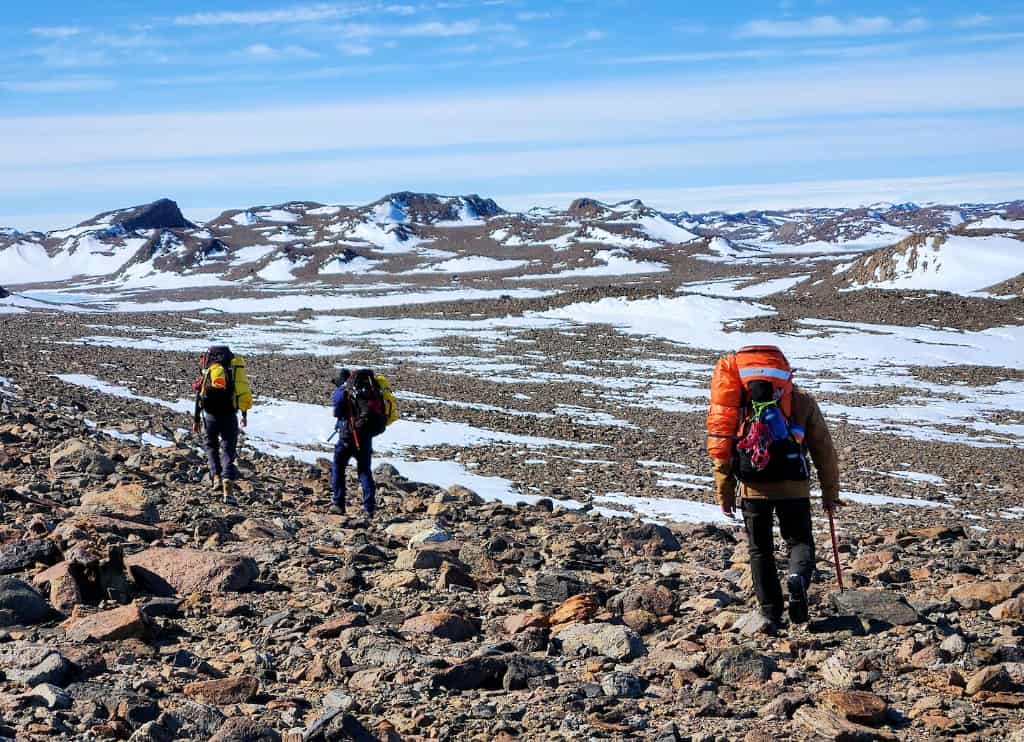
The helicopters will be used to fly scientists to remote locations in the Bunger Hills region. Photo: Simon Payne
A massive Royal Australian Air Force aircraft, usually used to move military equipment and distribute humanitarian aid, has delivered two BK117 helicopters to Antarctica for the first time. The helicopters will be used this summer to fly Australian Antarctic Program scientists to remote locations that would otherwise be inaccessible.
“To get the helicopters cleared for loading onto the C-17 we first had to take them up to Amberley Air Force Base in Queensland and put them through a loading trial with the Royal Australian Air Force,” Australian Antarctic Division chief helicopter pilot David Lomas said.
“We did that about six weeks ago and that was a practice run to identify any issues. It’s the first time this type of helicopter has been loaded on a C-17”.
The helicopters had their blades removed and were winched on to the C-17A Globemaster at Hobart Airport, before being tethered in a way that didn’t cause damage to their delicate frames.
“Normally we’re carrying quite heavy helicopters and equipment and these are quite light, so the main thing for us is making sure we don’t damage the aircraft as we’re bringing them on – that’s ours and the helicopters themselves,” Loadmaster Corporal Dalton King said.
“The main thing is making sure they don’t strike anything, especially the tail rotor.”

Ambitious deep-field campaign
After nearly five hours in the air, the Globemaster reached Wilkins Aerodrome and the helicopters were winched off in −10 degrees (balmy, by Antarctic standards).
Once their blades were reattached, they flew to Casey for the night and then on to the Bunger Hills.
The BK117s, along with two pilots and two engineers, will be based at Edgeworth David Base camp (EDBC) for the summer and used by scientists to get to remote locations they couldn’t reach any other way.
This year, 27 scientists will be based at EDBC, working with the Australian Antarctic Program’s Denman Terrestrial Campaign (DTC).
The scientists are from Securing Antarctica’s Environmental Future (SAEF), the Australian Centre for Excellence in Antarctic Science (ACEAS) and the Australian Antarctic Partnership Program (AAPP).
The DTC is a three-year program, examining the effects of climate change on the stability of the Denman Glacier and the region’s biodiversity.
Many of the scientists will also spend time at remote satellite camps, collecting samples or placing monitoring devices to be collected in 2024.
‚Blizzards are a problem when you’re parked outside‘
The scientists, pilots and engineers will sleep in tents for the duration. Their helicopters will have to brave the elements.
“When we’re out at the Bunger Hills the helicopters will be living outside, we don’t have the luxury of a hanger like we do at Davis,” David Lomas said.
“Every day we’ll be looking ahead at the forecast for the coming days and from there we’ll scale up our preparations – everything from tying the helicopters down to the ice to removing the blades so they can’t get damaged in high winds.”
To tie the helicopters down, v-shaped channels are drilled into the ice so ropes can be threaded through.
If high winds are forecast, the helicopter blades have to be removed before they hit 25 knots and if there’s the risk of a blizzard, every panel is taped.
“Blizzards are a problem when you’re parked outside,” Mr Lomas said.
“The fine, wind-blown snow gets in to every crack and opening and the helicopter can fill up with snow and ice quite easily.
“If there’s an event like that, our engineers will go over the vehicle with a fine-toothed comb and open up all the panels and have a really good look at the aircraft to make sure there’s no snow or ice in critical components.”
‚I really love the flying we do down here‘
Tradespeople and field training officers are already hard at work at EDBC, putting the final touches to mess tents, the kitchen and other amenities.
„I think we all had a few little nerves on the plane but we’re all really excited for it,“ Mr Lomas said.
„We love the flying we do down here and it’s really exciting to be embedded with the science teams, seeing them get the success they want to get and enabling them to get to the places they want to get to.“
The scientists fly to Wilkins at the end of November or early December, make the 70 kilometre trip to Casey station on a terra bus and then travel by ski plane to the base camp. Then, the real work begins.
Australian Antarctic Division
www.antarctica.gov.au








